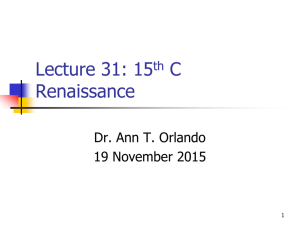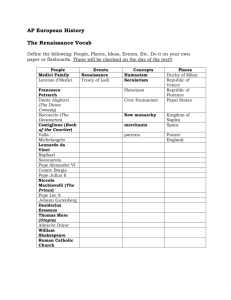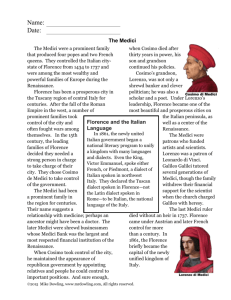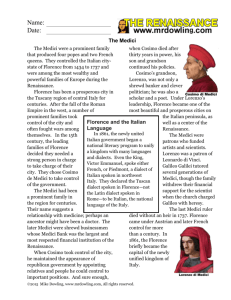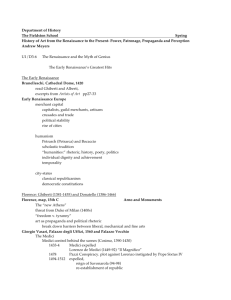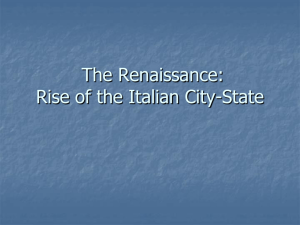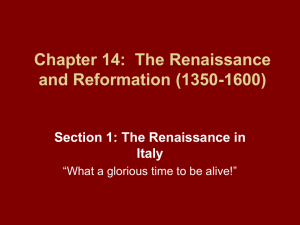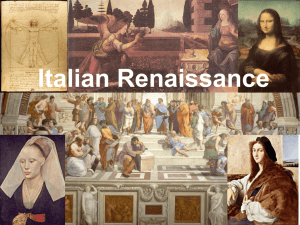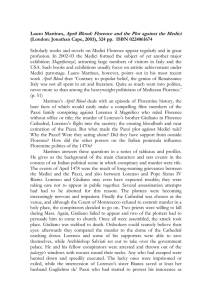1) Where did the Renaissance originate from? (Be specific, city and
advertisement
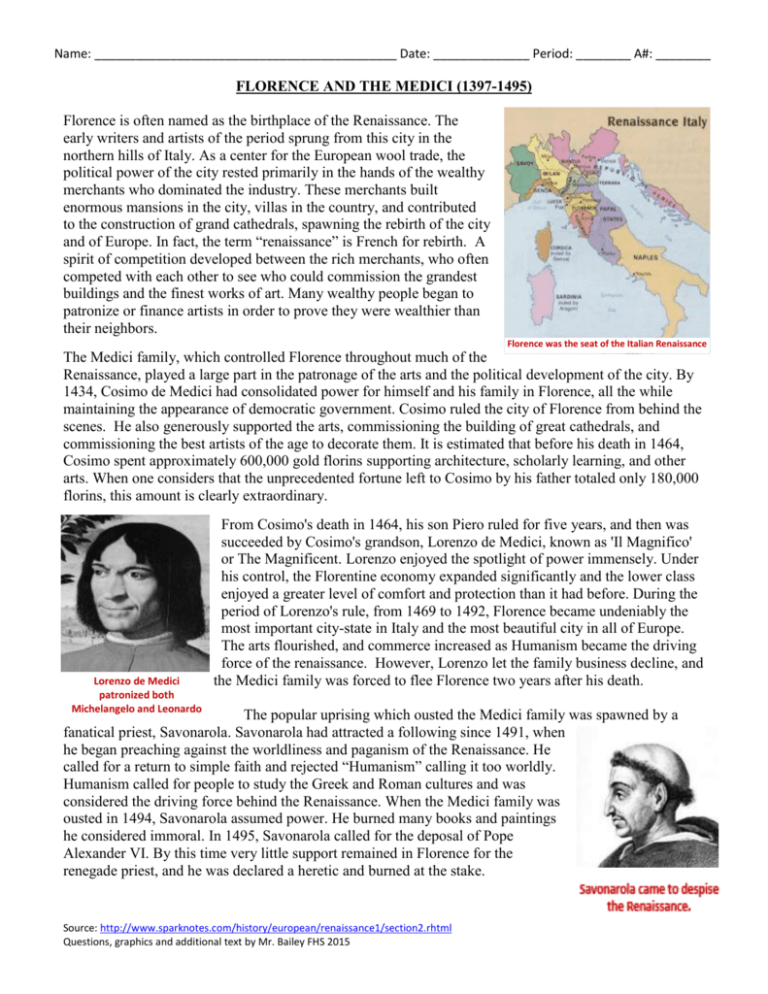
Name: ____________________________________________ Date: ______________ Period: ________ A#: ________ FLORENCE AND THE MEDICI (1397-1495) Florence is often named as the birthplace of the Renaissance. The early writers and artists of the period sprung from this city in the northern hills of Italy. As a center for the European wool trade, the political power of the city rested primarily in the hands of the wealthy merchants who dominated the industry. These merchants built enormous mansions in the city, villas in the country, and contributed to the construction of grand cathedrals, spawning the rebirth of the city and of Europe. In fact, the term “renaissance” is French for rebirth. A spirit of competition developed between the rich merchants, who often competed with each other to see who could commission the grandest buildings and the finest works of art. Many wealthy people began to patronize or finance artists in order to prove they were wealthier than their neighbors. Florence was the seat of the Italian Renaissance The Medici family, which controlled Florence throughout much of the Renaissance, played a large part in the patronage of the arts and the political development of the city. By 1434, Cosimo de Medici had consolidated power for himself and his family in Florence, all the while maintaining the appearance of democratic government. Cosimo ruled the city of Florence from behind the scenes. He also generously supported the arts, commissioning the building of great cathedrals, and commissioning the best artists of the age to decorate them. It is estimated that before his death in 1464, Cosimo spent approximately 600,000 gold florins supporting architecture, scholarly learning, and other arts. When one considers that the unprecedented fortune left to Cosimo by his father totaled only 180,000 florins, this amount is clearly extraordinary. Lorenzo de Medici patronized both Michelangelo and Leonardo From Cosimo's death in 1464, his son Piero ruled for five years, and then was succeeded by Cosimo's grandson, Lorenzo de Medici, known as 'Il Magnifico' or The Magnificent. Lorenzo enjoyed the spotlight of power immensely. Under his control, the Florentine economy expanded significantly and the lower class enjoyed a greater level of comfort and protection than it had before. During the period of Lorenzo's rule, from 1469 to 1492, Florence became undeniably the most important city-state in Italy and the most beautiful city in all of Europe. The arts flourished, and commerce increased as Humanism became the driving force of the renaissance. However, Lorenzo let the family business decline, and the Medici family was forced to flee Florence two years after his death. The popular uprising which ousted the Medici family was spawned by a fanatical priest, Savonarola. Savonarola had attracted a following since 1491, when he began preaching against the worldliness and paganism of the Renaissance. He called for a return to simple faith and rejected “Humanism” calling it too worldly. Humanism called for people to study the Greek and Roman cultures and was considered the driving force behind the Renaissance. When the Medici family was ousted in 1494, Savonarola assumed power. He burned many books and paintings he considered immoral. In 1495, Savonarola called for the deposal of Pope Alexander VI. By this time very little support remained in Florence for the renegade priest, and he was declared a heretic and burned at the stake. Source: http://www.sparknotes.com/history/european/renaissance1/section2.rhtml Questions, graphics and additional text by Mr. Bailey FHS 2015 Savonarola came to despise the Renaissance. Name: ____________________________________________ Date: ______________ Period: ________ A#: ________ All questions must be answered in complete sentences or no credit! 1) Where did the Renaissance originate from? (Be specific, city and country). _________________________________________________________________________ 2) What does the term “Renaissance” mean? _________________________________________________________________________ _________________________________________________________________________ 3) What does it mean to patronize someone? Why did the wealthy patronize artists in the Renaissance? _________________________________________________________________________ _________________________________________________________________________ 4) How many Gold Florins did Cosimo de Medici spend on the arts before his death? _________________________________________________________________________ 5) What was Lorenzo’s nickname? What happened to Florence when Lorenzo controlled it? _________________________________________________________________________ _________________________________________________________________________ 6) What was the driving force behind the Renaissance? (Hint: focusing on Greek and Roman culture). _________________________________________________________________________ _________________________________________________________________________ 7) Who took over Florence after Lorenzo’s death? What happened to him? _________________________________________________________________________ _________________________________________________________________________ Using your computer find out the answers to each of the following questions and write the answers in complete sentences on your own paper. Even if you recall the answers from your memory, use the textbook to double check your answers. These questions are on the final! 1) A brilliant cultural movement swept Europe from 1300 to 1600 known as this. 2) Any technique that gives a three-dimensional appearance to paintings is known as this. 3) Writers abandoned the use of classical Latin and wrote in their native language, a technique known as this. 4) The most powerful family in Florence, Italy was responsible for many commissions of arts. Who were they? 5) Michelangelo preferred to be known as one of these, probably one of the reasons why he objected to painting The Sistine Chapel. 6) Describe Michelangelo’s Sistine Chapel, his David, and his Pieta using at least one sentence for each. 7) Leonardo Da Vinci had a unique personality; he even bought these to set them free. 8) Describe Leonardo’s paintings Mona Lisa and The Last Supper in at least two sentences each. 9) What is the name of both of the techniques that Leonardo invented? Describe each one. 10) Who painted The School of Athens and who was added into it at the last second? Why was he added in? Source: http://www.sparknotes.com/history/european/renaissance1/section2.rhtml Questions, graphics and additional text by Mr. Bailey FHS 2015 Name: ____________________________________________ Date: ______________ Period: ________ A#: ________ Source: http://www.sparknotes.com/history/european/renaissance1/section2.rhtml Questions, graphics and additional text by Mr. Bailey FHS 2015
